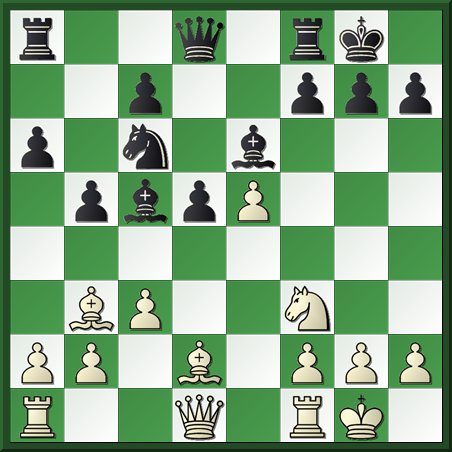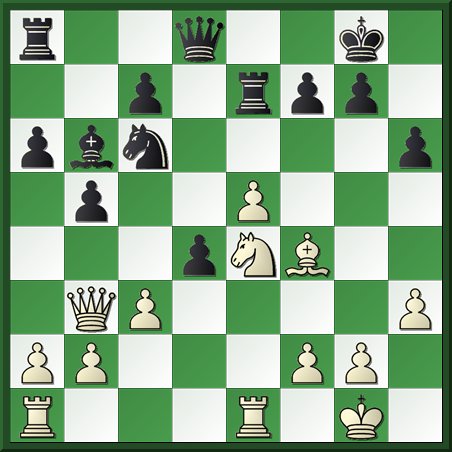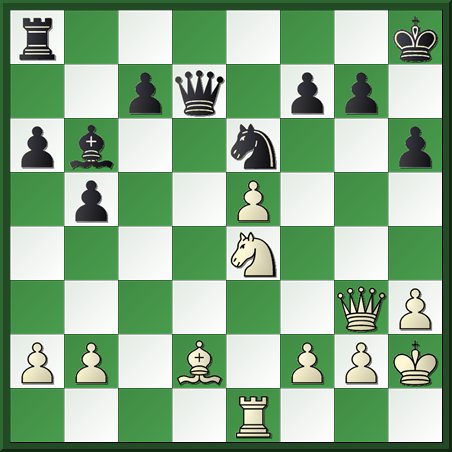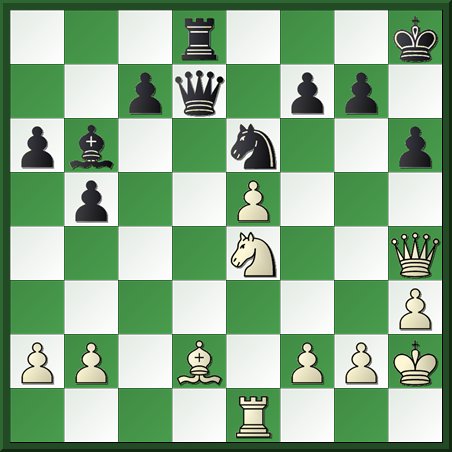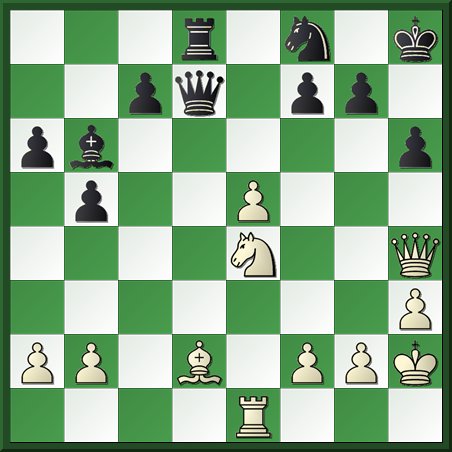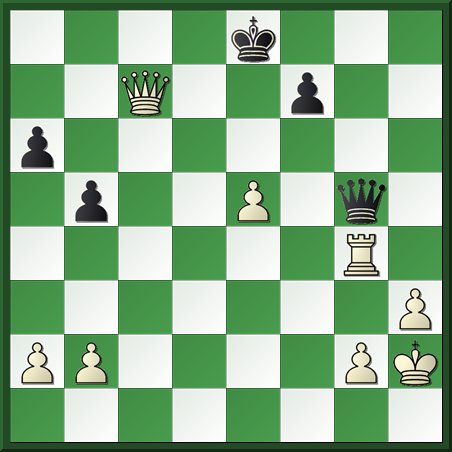All
the |
(Navigation bar
directly below.)
*******
© A.J. Goldsby, 2015.
(All rights reserved.)
****************
Click HERE
to see my
Chess Items.
****************
****************
Buy a book
from Amazon.com
(And help me out as well!)
****************
Click HERE
...
to see a list of the businesses that help to sponsor all of
my chess efforts.
|
Click HERE to see an explanation of the symbols that I commonly use when I annotate any chess game. Click HERE to replay this game. Click HERE to see my video channel on the "You-Tube" channel. (Click HERE to see my YT video on this game.) |
|
|
|
[A.J.G.]
My second round game vs. my friend Doug Strout. (The Crosstable for this event.)
This is one of my nicer and more
pleasing KP games ... in a long, long time. Both sides play moves that appear to be both normal
and natural.
However, White is slowly pointing all of his pieces at the Black King, and when the
time is right, White strikes.
(A perfect illustration of the "Alekhine Principle." That is, you first get all of your
pieces to their best squares, and then look for your big opportunity for a tactical
breakthrough. If you study enough of Alekhine's games, it becomes obvious
that he both knew of this concept, and was able to bring it off in a quite
a few of his games.)
The time control was:
"Game in 45 minutes."
(Plus a five-second delay/nai-increment; which is pretty much standard for all USCF tournaments.)
******************************************************************************************************************************************
The first ten (or so) moves are all standard "book" moves here. (Open Ruy Lopez.)
1.e4 e5; 2.Nf3 Nc6; 3.Bb5 a6; 4.Ba4 Nf6; 5.0-0 Nxe4;
6.d4 b5;
7.Bb3 d5; 8.dxe5 Be6; 9.c3 Bc5; 10.Nbd2 Nxd2;
This makes White's task easier, probably simply castles would have been a better move.
[ The main line would be: (>/=) 10...0-0; 11.Bc2 Bf5; 12.Nb3,
"+/=" 12...Bg6; (solidity)
when - according to theory - White has a solid plus, but Black's position is playable.
[ See MCO-15, page #72; col. # 46 and all notes ... especially # (q.) here. ] ]
11.Bxd2, (Which way to retake?)
To me, this appears to be the most natural recapture, although some sources (also) give taking on d2
with the WQ instead.
11...0-0; (Middlegame plan?)
The opening is pretty much over.
|
|
r2q1rk1/2p2ppp/p1n1b3/1pbpP3/8/1BP2N2/PP1B1PPP/R2Q1RK1 w - - 0 12
White has a slight edge, the only
question is:
"How does White play this position to try and (realistically) increase his
advantage?"
12.h3!?, (Waiting, controls g4.)
This move (h3) prevents any pins and also provides the WK some luft. (It also keeps any of Black's
other pieces from arriving on g4 anytime soon.) In addition, it maintains the tension, prevents
exchanges and allows White to keep all of his options open. {Perhaps the main drawback of
h2-h3 is that it does not stop Black from playing the liberating advance of ...d5-d4; here.}
According to the Powerbook and all
of the engines, White should play Bg5 here.
(I saw this move, however, I rejected it as after 12.Bg5, Be7; many trades could occur and the
position would become drawish.)
[ The computer book recommends:
RR 12.Bg5 Ne7!?; 13.Nd4,
"+/=" (White is slightly
better.)
M. Babula (2343) - M. Motyka; Trinec, 2002. / 1-0, 54 moves. ]
12...Re8; (Routine.)
This is OK, although it is not a
vigorous move ... it is not (yet) clear what file the Black Rooks really belong on in this position.
[ Instead, after the continuation:
(>/=) 12...Qd7; 13.Re1, "+/=" 13...d4;
"<=>"
(and) Black has good counterplay. - Fritz 13.
]
13.Re1 d4!?; 14.Ng5!?,
(Probing.)
Trying to keep the game alive, I go for (unclear) complications ... which is somewhat typical of my style. (Good ... or bad?)
[ The machine (instead) gives:
>/= 14.Bxe6! fxe6[]; {Box?}
This is pretty much forced.
(Instead, after the line:
</= 14...Rxe6?!; 15.Ng5! Rxe5;
16.Qh5!‚ "--->" (with an attack)
all the engines consider White to be nearly winning here. )
15.cxd4 Nxd4;
16.Be3 Nxf3+;
17.Qxf3 Bxe3; 18.Qxe3, "+/=" (White
has an advantage here.)
According to the machine, White is solidly better here.
However, I do NOT like this position ... (for White).
I think that - if I were playing the Black pieces - I would be able to hold this position.
(I think that this position is really too simplified for White to have a realistic chance of actually winning the game.)
]
14...Bxb3?!; (Inferior.)
This line is decidedly worse than the engine move of ...dxc3. Now White gets a big advantage here.
[ A definite improvement over the course of the actual game would have been the following line:
RR >/= 14...dxc3!; 15.Nxe6!,
"~" (A very wild and unclear position.)
]
15.Qxb3 Re7; {Forced?}
Some engines don't like this move, however, after much consideration and machine-assisted analysis, I believe that it is best. {"Box."}
[ Not 15...Nxe5?; 16.Rxe5! Rxe5; 17.Nxf7 Qd5; 18.Nxe5, "+/-" (+-) and White is winning. ]
16.Bf4, (Protects e5.)
Once more, I keep the position alive and purposely avoid swaps, in an attempt to try and see if my opponent will make a mistake.
[ The machine prefers: (>/=)
RR 16.e6! f6; 17.Nf7, "+/" (
'±' - White is clearly better.) 17...Qe8;
however, I was uneasy about "burying" my WN on f7. It also seems that Black can play ...Nd8;
anytime that he needs to rid himself on the annoying unit on the f7-square.
]
16...h6; 17.Ne4 Bb6;
("=")
After many adventures, we have arrived back at a position that just about all the engines seem to consider to be ... dead equal!
|
|
r2q2k1/2p1rpp1/pbn4p/1p2P3/3pNB2/1QP4P/PP3PP1/R3R1K1 w - - 0 18
Now I begin a maneuver to bring my Queen over to the King-side.
18.cxd4 Nxd4; 19.Qg3 Kh8;
The metal monster (chess engines) show that this was forced, it was just common sense to get the BK off the g-file here.
20.Kh2!, (Best, avoids problems.)
An overnight DPA shows this to be the best possible solution to any problems that White might face.
("D.P.A." = Deep position analysis, done with a strong computer and a good engine, usually overnight.)
[ Of course NOT: </=
20.Rad1?? Ne2+; 21.Rxe2 Qxd1+; 22.Kh2 Qxe2;
"-/+" ("minus - plus")
when Black is easily winning. ]
Now Fritz 13 likes 20...Qc8; however, this move appears (to me) to be both ugly and rather artificial ...
20...Ne6;
21.Rad1 Rd7;
22.Rxd7 Qxd7; 23.Bd2, "="
This looks like White's most natural move, especially seeing as how I was (still) trying to avoid exchanges.
|
|
r6k/2pq1pp1/pb2n2p/1p2P3/4N3/6QP/PP1B1PPK/4R3 b - - 0 23
According to all of the engines, the current position is still completely level here.
(For this game, I used the following engines: Fritz 13, Rybka 4, Houdini 2.0 ... and also Deep Shredder as well.)
[ RR 23.Bc1!? Ba5!; "=" (Equal.) ]
Now 23...Qd5!; appears to be Black's most energetic move here ... ... ...
(This would have also avoided all of the problems that Black had in the game as well.)
23...Rd8!?; (hmmm)
Technically, there is nothing wrong with this move. Yet Black gets into a lot of difficult problems as a result of this play, so maybe the second player should have played something else, instead.
24.Qh4!, (With a few threats.)
With this sharp, bold move, I threaten to capture on h6, and this is a problem that is not easily solved here.
|
|
3r3k/2pq1pp1/pb2n2p/1p2P3/4N2Q/7P/PP1B1PPK/4R3 b - - 0 24
The question becomes, how does Black prevent this from occurring?
[ RR 24.b3 Nc5; "=" ]
24...Nf8; ('?!' or even '?' -- A bad error.)
This moves looks reasonable, Black prepares to bring more pieces over near his King.
|
|
3r1n1k/2pq1pp1/pb5p/1p2P3/4N2Q/7P/PP1B1PPK/4R3 w - - 0 25
However, in all honesty, this move is incorrect ... and allows White to make a winning sacrifice.
[ >/= 24...Nd4!; 25.Bxh6!? Nf5!; "<=>" (Black has some counterplay.) ]
I now pondered for close to half an hour before playing my next move.
25.Bxh6! gxh6?; (A
definite mistake.)
Mr Strout decides to accept the challenge and accept the sack.
Black could not capture on h6, the machine shows that it is suicide and is practically the equivalent of Black tendering his resignation at this point.
[ Black had to play:
>/= 25...Ng6[]; when 26.Qh5, is a nice attack for White,
but maybe Black can try to hold on, and the second player is only down a single
Pawn - which is not really a decisive advantage. ]
26.Qxh6+ Nh7[]; (Forced.)
Black had to play this, playing the Black King to g8 is simply met by Nf6#.
27.Nf6! Qf5; 28.Nxh7 Qxh7!?;
Another incorrect move, Black had to play ...Qg6; when White will come out two Pawns ahead.
(See the analysis - just below.)
[ >/= 28...Qg6!;
29.Qxg6 fxg6;
30.Ng5 Bxf2; 31.Re2 Rf8;
32.Ne6 Rf7; 33.Nxc7! Rxc7; 34.Rxf2,
"+/-" (White is winning.) ]
The rest of the game is a virtual mop-up operation for White.
29.Qf6+ Qg7;
30.Qxd8+ Kh7;
31.Qh4+ Kg8; (A bad idea?)
This move is also inaccurate, now White can play Re4, with an easy win from here.
[ Instead, after the moves:
>/= 31...Qh6; 32.Qxh6+ Kxh6;
33.e6 fxe6; 34.Rxe6+ Kg7;
35.Rxb6 cxb6; 36.Kg3, "+/-"
is a better defense for Black, but White is still winning easily. ]
32.Re4! Bxf2!?; 33.Qxf2 Kf8;
34.Qc5+ Ke8; 35.Qxc7 Qg5;
36.Rg4, "+-"
Black Resigns.
Black has had enough ... and so tosses in the towel. (White played a pleasing sacrifice in this game.)
|
|
Copyright (c) A.J. Goldsby, 2013. All rights reserved.
[ White is also winning after the following continuation:
RR 36.e6! fxe6; 37.Rxe6+ Kf8;
38.Qc8+ Kg7;
39.Qd7+ Kh8;
40.Qf7!, "+-" ("plus / minus")
which is what the machine prefers. ]
1 - 0
More resources
-
The CG web page for this line, (up until just before 9.c3).
-
An excellent Wikipedia article on the Ruy Lopez. (Good stuff, lots of external links.)
-
Maybe the best, (most current) book on this opening. (By GM Glenn Flear.)
-
Here is a game/lesson ... with two GM's playing the Open System of the Ruy Lopez / Spanish Game. (Nicely annotated.)
-
Here is another game with an Open Ruy Lopez, GM Judit Polgar smashes GM S. Mamedyarov! (Again, annotated by me.)
-
Karpov smashes Korchnoi in the Open Roy Lopez!!! (Another one, although it takes 41 moves, this time.)
-
Kasparov defeats Anand in an Open Ruy Lopez, one of Garry's most celebrated wins from his 1995 WCS Match.
The analysis for this page was prepared with the excellent program,
ChessBase
10.0.
(I now have
ChessBase 11.0; I also used MANY different chess engines!) (I now have
ChessBase 11.0; I also used MANY different chess engines!)
The HTML was polished with several different tools and programs, (mostly FP) ... the text was checked for spelling with MS Word..
|
Go ... or return ... to my Home Page for this site. Go (or return) ... to my "Annotated Games" (II) Page. Go
... or return ... to my "Best
Games" Page. *******
Copyright (c)
LM A.J. Goldsby
I ******* This
page was first generated in: February, 2013. Final
format and posted on: Sunday;
May 26th, 2013. |
